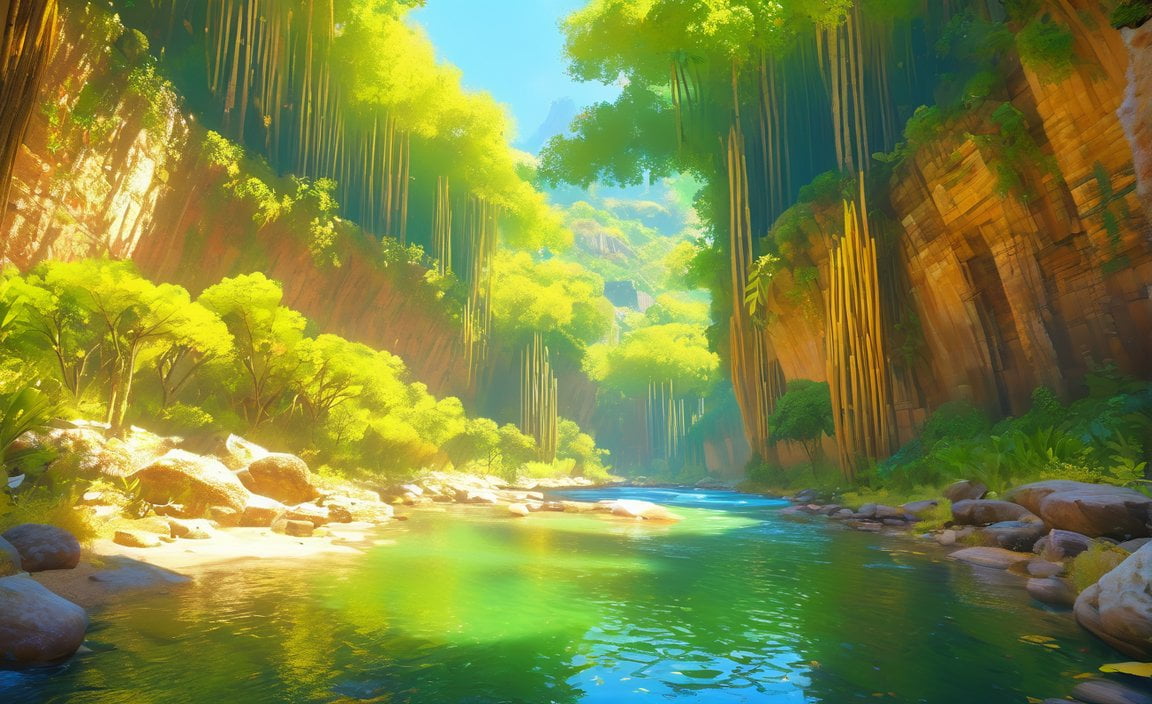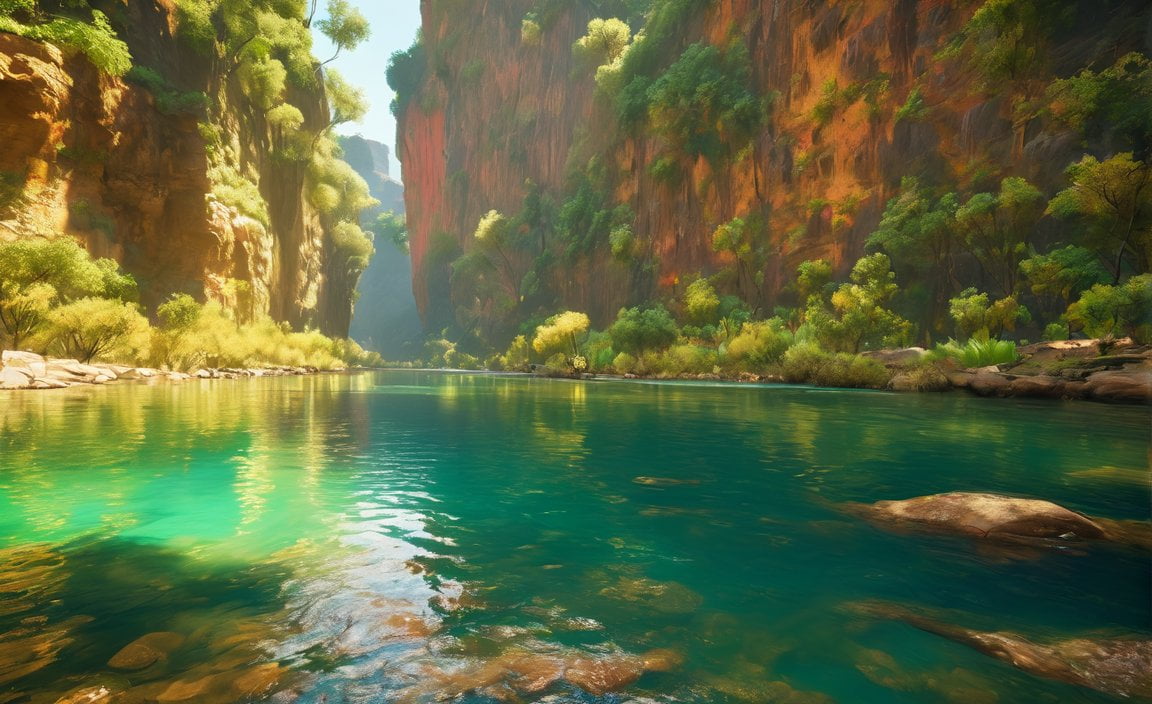Unveiling Mexico’s Majestic Rivers: Discovering the Hidden Ecological Treasures takes us on an immersive journey through the mesmerizing rivers that gracefully flow across the vibrant landscapes of Mexico. From the untamed strength of the Rio Grande to the mystical allure of the Usumacinta, these waterways hold a wealth of ecological wonders waiting to be uncovered. This article delves into the cultural, historical, and environmental significance of each river, shedding light on the efforts needed to protect and sustain these invaluable ecosystems for future generations.

Key Takeaways:
The Rio Grande is the longest river in Mexico, serving as a significant crossing point between the U.S. and Mexico. It plays a crucial role in trade and transportation.
The Colorado River is the second-longest river in Mexico, providing water to both Mexico and the U.S. It supports various ecosystems and human settlements.
The Lerma River is a vital waterway that supports Lake Chapala, the largest natural lake in Mexico. It provides water for irrigation, drinking, and economic activities in the region.
Mexico’s rivers are home to diverse wildlife, including birds, fish, reptiles, and amphibians. Popular attractions along these rivers include the Rio Secreto and the Grijalva River, known for their scenic beauty.
Rivers in Mexico play a crucial role in providing freshwater for both urban and rural areas, supporting agriculture, industry, and domestic needs. Mexico prioritizes efforts to protect and manage these water resources sustainably.
Sources:
– Adequate Travel. Top 10 Famous Rivers in Mexico
– Britannica. Rio Grande | Definition, Location, Length, Map, & Facts
– WorldAtlas. Longest Rivers In Mexico
River through Mexico
Mexico is blessed with a diverse network of rivers that flow through its magnificent landscapes. These rivers not only contribute to the country’s ecosystem but also offer a wealth of natural treasures waiting to be discovered. From the iconic Rio Grande to the lesser-known Lerma River, each waterway has its own unique attributes and contributes to the vibrant tapestry of Mexico’s natural beauty. Join me as I take you on a journey through the remarkable rivers that flow through Mexico.
The Rio Grande: A Famous Crossing Between the U.S. and Mexico
One of Mexico’s most famous rivers is the Rio Grande, also known as Rio Bravo. This majestic river stretches across Mexico City, originating from the Gulf of Mexico. Spanning an impressive length of approximately 1,896 miles, the Rio Grande holds immense significance as a crucial crossing point between the United States and Mexico. It forms part of the border between these two nations, playing a vital role in trade and transportation. The Rio Grande is a lifeline, connecting communities on both sides of the border and nurturing a sense of unity and cooperation.
The Colorado River: Second-longest River in Mexico
Following the Rio Grande, the Colorado River holds the distinction of being the second-longest river in Mexico. Its journey begins in the Gulf of California, covering a vast expanse of Mexican territory before flowing through several states in the United States. The Colorado River is a lifeline for both Mexico and the U.S., serving as a vital source of water for various ecosystems and human settlements along its course. This mighty river sustains a delicate balance between nature and human needs, exemplifying the importance of responsible water management.
Lerma River: A Vital Waterway Supporting Lake Chapala
Nestled west of Mexico City, the Lerma River is a vital waterway that originates in the Toluca Basin. This scenic river flows westward, playing a crucial role in supporting Lake Chapala, the largest natural lake in Mexico. The Lerma River serves as a lifeline for the region, providing water for irrigation, drinking, and various economic activities. It is a testament to the interconnectedness of land and water, nurturing a delicate ecosystem and supporting a rich diversity of flora and fauna. The Lerma River and Lake Chapala are truly a sight to behold, attracting tourists who seek to immerse themselves in the captivating beauty of Mexico’s natural landscapes.
Wildlife and Attractions Along Mexico’s Rivers
Mexico’s rivers are teeming with an abundance of wildlife, offering a sanctuary for various species. Along these picturesque waterways, you can witness a mesmerizing array of creatures, ranging from vibrant birds and diverse fish to majestic reptiles and enchanting amphibians. The Rio Secreto, a massive underground river, and the Grijalva River in Tabasco are among the popular attractions that captivate visitors with their scenic beauty. Embarking on a river adventure in Mexico allows nature enthusiasts to engage in activities such as boating, fishing, and wildlife spotting, creating memorable experiences that foster a deep appreciation for our natural world.
Climate and Importance of Rivers in Mexico
The climate along Mexico’s rivers varies, showcasing the country’s diverse geography. From arid and semiarid regions to tropical areas with abundant rainfall, these rivers adapt to their surroundings, shaping both the environment and the communities that rely on them. The rivers serve as a vital source of freshwater, supporting urban and rural areas alike. Agriculture, industry, and domestic needs all benefit from these precious water resources. With nearly 245 rivers flowing throughout the country, Mexico places great importance on protecting and sustaining these invaluable ecosystems, ensuring a sustainable future for generations to come.
In conclusion, Mexico’s rivers are not mere waterways but powerful conduits that connect nature, culture, and heritage. The Rio Grande and the Colorado River stand as mighty symbols of cooperation and vitality, while the Lerma River brings life to the picturesque Lake Chapala. Experiencing Mexico’s majestic rivers allows us to witness the wonders of biodiversity, embark on thrilling adventures, and cultivate a deep respect for the delicate balance of nature. Let us join hands in preserving these magnificent rivers, protecting the ecosystems they support, and cherishing the invaluable gifts they bestow upon Mexico and the world.
Sources:
– Adequate Travel. Top 10 Famous Rivers in Mexico
– Britannica. Rio Grande | Definition, Location, Length, Map, & Facts
– WorldAtlas. Longest Rivers In Mexico
- Guam coordinates: Explore the precise coordinates of Guam and uncover its unique geographical location.
- Little Rock to Birmingham: Embark on a thrilling journey from Little Rock to Birmingham and witness the stunning landscapes along the way.
- In which hemisphere is Australia located: Discover the fascinating answer to the question of which hemisphere Australia is situated in.
- Palaces in ancient Egypt: Immerse yourself in the grandeur and mystique of the magnificent palaces that existed in ancient Egypt.
- Architecture of Sparta: Dive into the rich architectural heritage of Sparta and marvel at its iconic structures and designs.
- Thailand braids: Uncover the intricate and exquisite art of Thai braids, a beautiful and traditional hairstyle.
- Virgin Islands language: Delve into the captivating language spoken in the enchanting Virgin Islands and explore its unique linguistic characteristics.
Exploring the Ecological Importance of Rivers in Mexico: Preserving Unique Habitats
Key Takeaways:
River ecosystems in Mexico are dynamic and provide essential ecosystem services such as water purification, flood control, and habitat for diverse species.
Human activities, including the pharmaceutical industry, contribute to pollution in river ecosystems, endangering their health and the unique habitats they sustain.
Pharmaceutical waste, including microplastics and antibiotics, poses significant risks to the ecological balance of rivers, affecting both humans and aquatic organisms.
Maintaining the ecological health of river ecosystems requires proactive measures to reduce pollution and preserve the intricate web of interactions between living organisms and their environment.
Importance of River Ecosystems
Rivers are not merely water bodies; they are dynamic ecosystems that play a crucial role in maintaining the health of our environment. They provide various ecosystem services and support a diverse range of species. As one of the most dynamic ecosystems in the world, rivers serve as the lifeline for countless organisms and contribute to the balance of nature [^3^].
These unique habitats are not restricted to providing water resources; they also help purify water by filtering out pollutants and sediments. Moreover, river ecosystems act as natural flood control systems, preventing excessive water flow during heavy rainfall and protecting surrounding areas from inundation [^6^].
Ecological Interactions in River Ecosystems
Every drop of water in a river carries the story of countless lives and their intricate interconnections. River ecology refers to the complex relationships between living organisms and their environment in these ecosystems [^4^]. It encompasses a diverse web of interactions between plants, animals, microorganisms, and the non-living components that make up the river ecosystem.
One defining characteristic of river ecosystems is water flow, which sets them apart from other water bodies. The continuous movement of water not only shapes the physical landscape of rivers but also influences the ecological dynamics of these habitats. From the smallest microorganisms to the largest aquatic creatures, all life in a river is shaped by the perpetual motion of water [^7^].
Impact of Pharmaceutical Waste
While rivers provide numerous benefits, they are also vulnerable to pollution caused by human activities. The increasing demand for pharmaceutical products has resulted in the release of harmful waste, including microplastics, pharmaceuticals, and antibiotics, into river ecosystems [^1^].
Microplastics, for instance, pose a significant threat to river ecosystems. These small plastic particles not only accumulate in aquatic organisms but also disrupt the delicate balance of the ecosystem. Additionally, the presence of antibiotics in rivers can lead to the structural changes in microbial communities, impacting the overall biodiversity and ecological functions of the ecosystem [^5^].
Concerns for River Ecosystem Health
The pollution brought about by pharmaceutical waste poses a grave concern to the health and well-being of river ecosystems. Continuous exposure to these pollutants exceeds the capacity of rivers to assimilate and regenerate, creating imbalances in the ecosystem and affecting the biota and river ecology [^2^].
It is vital to address these concerns and implement measures that mitigate the impact of pharmaceutical waste on river ecosystems. By employing sustainable practices and adopting proper waste management techniques, we can preserve the ecological health and intrinsic value of these precious habitats for future generations.
Preserving Mexico’s River Ecosystems
Preserving the unique habitats sustained by Mexico’s rivers requires collective efforts from both industries and individuals. The pharmaceutical industry, in particular, should prioritize reducing waste and implementing sustainable manufacturing processes to minimize the release of harmful substances.
Furthermore, raising awareness among the public about the ecological importance of rivers and the impact of pharmaceutical waste is crucial. By making informed choices, individuals can contribute to the conservation of these ecosystems. Conserving water resources, reducing the use of unnecessary pharmaceutical products, and properly disposing of waste are steps that everyone can take towards protecting these remarkable habitats.
In conclusion, Mexico’s rivers are not just scenic treasures but also serve as vital lifelines for both ecological and human well-being. Exploring the ecological importance of these rivers and understanding the unique habitats they sustain is an essential step in preserving these natural wonders. By addressing the concerns related to pharmaceutical waste and implementing sustainable practices, we can ensure the longevity of Mexico’s majestic rivers and the diverse ecosystems they support.
Sources:
[^1^] ScienceDirect – Ecological Significance of River Ecosystems. Available: Link
[^2^] ScienceDirect – River Ecosystem – an overview. Available: Link
Rivers and their Cultural Values: A Comprehensive Analysis
Rivers hold immense cultural significance and play a vital role in human societies. They serve as sources of water, transportation routes, and habitats for various species. Moreover, rivers have deep-rooted connections with cultural beliefs, values, and ways of life. Understanding the cultural importance of rivers is crucial for appreciating the diverse ways in which they are perceived, utilized, and governed.
Cultural Water Governance and Interpretations
One of the key aspects of comprehending rivers’ cultural significance lies in studying water governance arrangements and interpretations[^1^]. Different cultures have unique perspectives on rivers and their roles in society. These interpretations influence the ways people relate to, know, and use rivers. By examining cultural water governance arrangements, it becomes possible to appreciate local solutions to water problems and gain insights into diverse cultural practices.
Interconnectedness of Rivers and Cultural Beliefs
Rivers connect people, places, and various forms of life, sustaining a wide range of cultural beliefs, values, and ways of life[^2^]. They inspire communities and provide the foundation for cultural identities. River flows have deep-rooted connections to floodplain agriculture, transportation, social exchange, and acts of reverence. The cultural significance of rivers is intricately intertwined with the well-being and livelihoods of local communities.
Historian’s Role in Studying Rivers
The study of rivers requires a broader engagement by historians, considering their multifaceted roles in history[^3^]. Historians should explore the significance of rivers in transportation, fishing, agriculture, industry, recreation, and environmental contexts. Additionally, understanding people’s cultural responses to rivers and the legal frameworks surrounding them, including their roles as political boundaries, provides valuable insights.
Cultural Values and Spiritual Significance of Water
Water possesses cultural and spiritual value that often defies any tangible definition[^4^]. Sociocultural values attributed to water play a significant role in shaping human interactions with this precious resource. Recognizing and appreciating the cultural and spiritual values of water is essential for effective water management and conservation practices.
Indigenous Perspectives on Water Justice
Indigenous peoples worldwide advocate for self-determination in their political, economic, and socio-cultural affairs, including their relationship with water[^5^]. Indigenous communities have unique perspectives on water justice, emphasizing the need for recognition and protection of their water rights. Addressing water colonialism and promoting Indigenous water justice plays a crucial role in achieving equitable and sustainable water management practices.
These selected sources provide valuable insights into the cultural values, interpretations, and governance arrangements related to rivers. They emphasize the interconnectedness between rivers and human societies, highlighting the need for holistic approaches to water management that consider the cultural significance of this invaluable resource.
Key Takeaways:
– Rivers have deep-rooted connections with cultural beliefs, values, and ways of life.
– Studying cultural water governance arrangements provides insights into diverse cultural practices.
– Rivers sustain cultural beliefs, inspire communities, and provide the foundation for cultural identities.
– Historians play a role in understanding the significance of rivers in various contexts.
– Water has cultural and spiritual value, shaping human interactions with this resource.
– Indigenous perspectives on water justice emphasize the need for recognition and protection of water rights.
[^1^]: Oxford Bibliographies – Rivers and Their Cultural Values: Assessing Cultural Water Requirements
[^2^]: Wiley Online Library – Understanding rivers and their social relations: A critical step to …
[^3^]: Springer – River Cultures in World History—Rescuing a Neglected Resource
[^4^]: IUCN – An insight into the cultural and spiritual value of water
[^5^]: Taylor & Francis Online – Full article: Water colonialism and Indigenous water justice in …
5. Discussion on the Current Threats Faced by Mexico’s Rivers and the Efforts to Protect and Conserve Them
Key Takeaways:
- Dams pose a significant threat to river biodiversity, disrupting the free-flowing nature of rivers and negatively impacting fish, aquatic insects, birds, and plants[^1^].
- Pollution and livestock overgrazing near rivers contribute to the loss of plants and increased erosion[^1^].
- The Ganges River basin faces challenges in ensuring adequate ecological flow and water quality due to dam construction and canal systems[^2^].
- Climate change poses a significant threat to freshwater fishes, yet they have been largely ignored in biodiversity discussions[^3^].
- Climate-related disasters, including water-related disasters, have nearly doubled in the past two decades[^4^].
- The health of the Yangtze River is critical for freshwater fisheries, water supplies, and flood mitigation[^5^].
- Transboundary water conflicts and resistance are prevalent in several river basins in South Asia[^6^].
Mexico’s rivers, with their diversity and ecological treasures, face various threats that endanger their ecosystems. Dams are one of the significant threats, disrupting the free flow of rivers and impacting the biodiversity within. Fish, aquatic insects, birds, and plants all suffer as a result. Additionally, pollution and livestock overgrazing near rivers contribute to the loss of vegetation and increased erosion. These human activities harm the delicate balance of river ecosystems and the creatures that depend on them.
The Ganges River basin in Mexico also faces challenges in maintaining adequate ecological flow and water quality due to the construction of dams and canal systems. This has significant implications for the overall health and sustainability of the basin. Furthermore, climate change poses a growing threat to freshwater fishes, impacting their populations and the ecological functions they perform. Unfortunately, the conservation efforts for freshwater fishes have not received adequate attention, further exacerbating the risks they face.
The increasing frequency of climate-related disasters, including water-related disasters, also poses a substantial threat to Mexico’s rivers. Over the past two decades, these disasters have nearly doubled in occurrence, highlighting the urgent need to address and mitigate their impacts. Moreover, the health of the Yangtze River is essential for freshwater fisheries, water supplies, and flood mitigation. Ensuring its preservation is crucial for the well-being of surrounding communities and ecosystems.
Mexico is not alone in facing challenges related to its rivers. Transboundary water conflicts and resistance are prevalent in several river basins in South Asia. These conflicts highlight the need for effective governance and management of shared water resources, ensuring sustainable use and ecological preservation.
Efforts are underway to protect and conserve Mexico’s rivers and prevent further degradation of their ecosystems. These efforts include raising awareness about the threats faced by rivers, implementing regulations to reduce pollution and ensure sustainable water management, and promoting transboundary cooperation to address shared water resources.
By understanding the current threats faced by Mexico’s rivers and the efforts being made to protect and conserve them, we can strive to safeguard these invaluable ecological treasures for future generations. Only through collective action and a commitment to sustainable practices can we ensure the continued health and vitality of Mexico’s rivers and the ecosystems they support.
Citations:
[^1^] The World Economic Forum. (2022, October). 5 big threats to rivers.
[^2^] Springer. (2019, April). Understanding the threats and challenges concerning Ganges River basin.

FAQ
Q1: What are some famous rivers in Mexico?
A1: Some famous rivers in Mexico include the Rio Grande, the Colorado River, and the Lerma River.
Q2: What is the importance of rivers in Mexico?
A2: Rivers in Mexico play a crucial role in the country’s ecosystem, supporting diverse wildlife, providing water for irrigation and economic activities, and serving as a vital source of freshwater for both urban and rural areas.
Q3: How do human activities impact river ecosystems in Mexico?
A3: Human activities, such as the release of pharmaceutical waste, pollution, and overgrazing near rivers, can negatively impact river ecosystems, causing stress on the biota and river ecology.
Q4: Why are dams a threat to river biodiversity in Mexico?
A4: Dams pose a significant threat to river biodiversity in Mexico as they disrupt the free-flowing nature of rivers and can negatively impact fish, aquatic insects, birds, and plants.
Q5: What are some challenges faced by river basins in Mexico?
A5: River basins in Mexico face challenges such as ensuring adequate ecological flow, maintaining water quality, and addressing the impacts of climate change and transboundary water conflicts.
- Sept 31 Myth: Unveiling Calendar Secrets - March 18, 2025
- How Long & Till December 18, 2025: Accurate Countdown Guide - March 18, 2025
- Discover Japanese Artists: A Complete History - March 18, 2025



![Exploring the Rich River Resources in [State with most rivers]: A Geographer's Perspective State-with-most-rivers_1](https://www.lolaapp.com/wp-content/uploads/2023/11/State-with-most-rivers_1-150x150.jpg)












